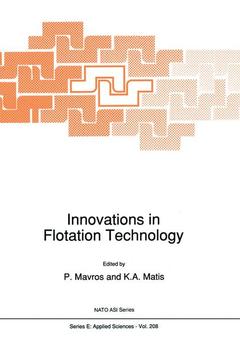Description
Innovations in Flotation Technology, Softcover reprint of the original 1st ed. 1992
NATO Science Series E: Series, Vol. 208
Coordinators: Mavros P., Matis Kostas A.
Language: English
Subjects for Innovations in Flotation Technology:
Keywords
Publication date: 11-2012
538 p. · 15.5x23.5 cm · Paperback
538 p. · 15.5x23.5 cm · Paperback
Description
/li>Contents
/li>
The present book is the outcome of an Advanced Study Institute meeting, which was held in Kallithea, Chalkidiki, in Northern Greece, from 12-25 May 1991 and attended by 69 delegates from 18 countries. The Institute brought together scientists, engineers and technologists currently involved in basic and applied research on the different aspects of flotation. The Institute covered subjects in four major areas of flotation: a) fundamentals; b) chemical technology aspects; c) mineral processing; and d) water and wastewater treatment. Apart from the papers reproduced in this volume, several short oral communications were also presented. Participants also had the opportunity to visit the Hellenic Chemical Products & Fertilizers Co. Ltd. mixed sulphides plant, in Chalkidiki. Conference participants, whose interest and research projects are in this broad field of science and engineering, provided a well-informed discussion of the problems encountered, as well as possible directions of future technological developments. It is hoped that this book is not only a good record of the presentations made (formal and informal), analyzing the state-of-the-art in flotation, but will also be helpful for students, scientists and technologists working in the fields of separation processes and in particular mineral processing and wastewater engineering. All the invited speakers and the participants made this summer school possible, worthwhile and enjoyable. The sponsorship by the NATO Scientific Affairs Division is gratefully ack nowledged. The Editors would like to thank the members of the Organizing Committee, Dr. B.A.
1. Fundamentals.- 1.1. The Study of Thin Aqueous Films as Models for Froths and Flotation.- 1.2. The Mechanisms of Collector Adsorption-Abstraction (Ionic and Non-Ionic Surfactants) on Heterogeneous Surfaces.- 1.3. Electrochemistry in the Plant.- 1.4. Flocculation of Fine Particles.- 1.5. Applied Mineralogy and Materials Balancing Procedures. Evaluations of Flotation Concentrators.- 1.6. Liberation by Size Reduction. Consequences and Improvements on Flotation Kinetics.- 1.7. Elements of Physically-Based Modelling of the Flotation Process.- 2 . Chemical Technology Aspects.- 2.1. Flotation Kinetics.- 2.2. Mixing and Hydrodynamics in Flotation Cells.- 2.3. Case Studies of Flotation Control.- 2.4. Mineral Surface Complexation in Flotation.- 2.5. Amide-Based Technologies in Flotation and Hydrometallurgy of Precious Metals.- 2.6. Determination of Floatability Data using the EmDee Microflot Method.- 2.7. Froth Flotation Kinetics - Theory and Model Experiments.- 2.8 Electrolytic Flotation.- 3. Mineral Processing.- 3.1. Features and Rotation of Complex Cu-Pb-Zn Sulphides.- 3.2. Interactions of Anionic Collectors in Flotation of Semi-Soluble Salt Minerals.- 3.3. Flotation of Salt-Type Minerals.- 3.4. Vibroacoustic Improvements of Froth Flotation.- 3.5. The Institute of Geology and Mineral Exploration (IGME) of Greece and its Research Activities on Flotation.- 3.6. The Influence of Multivalent Cations on the Floatability of Scheelite, Fluorite and Calcite.- 3.7. Non-Cyanide Technology for the Flotation of Lead-Zinc Ores.- 4. Water and Wastewater Treatment.- 4.1. Flotation in Water Treatment.- 4.2. Mechanism of Selective Ion Flotation.- 4.3. Flotation Techniques in Waste Water Treatment.- 4.4. Flotation of Pigments and Inks from Waste Paper.- 4.5. A Case Study of Flotation Appliedto an Edible Oil Factory Wastewater.- 4.6. The Need for Advanced Treatment of Stormwater Run-off from Separate Sewer Systems.- List of Contributors.- List of Participants.
© 2024 LAVOISIER S.A.S.




